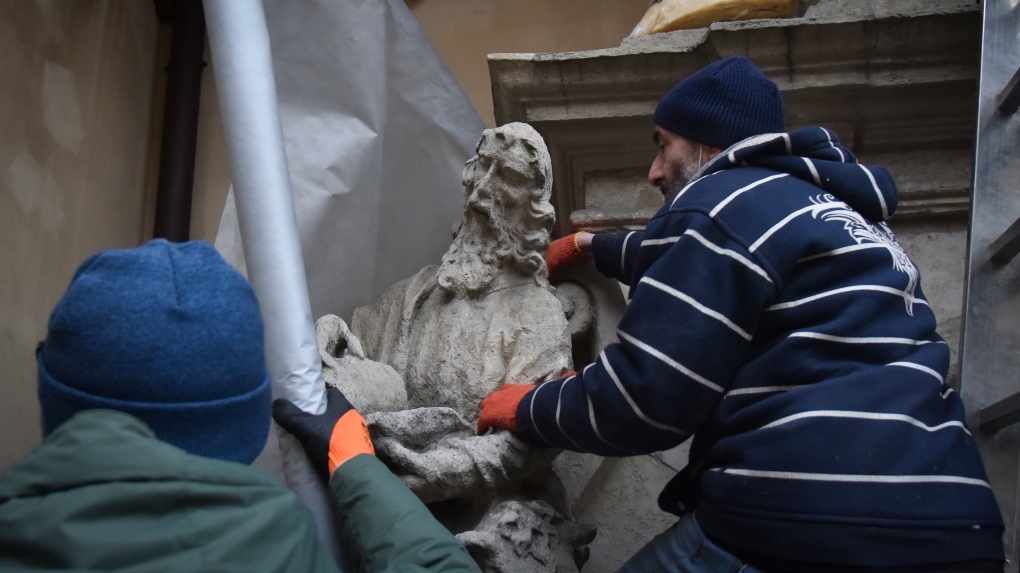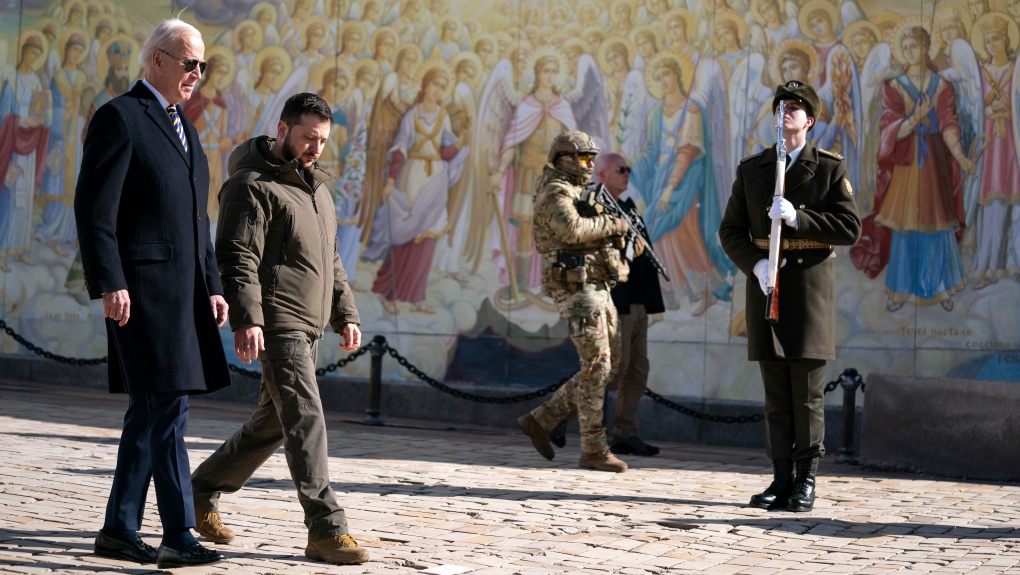
Norovirus spreading at 'higher frequency' than expected in Canada
Norovirus is spreading at a 'higher frequency' than expected in Canada, specifically, in Ontario and Alberta, according to the Public Health Agency of Canada.
Memory is a poor keeper of history. It grows and fades, and tricks with the passage of days, leading into weeks, leading into months, leading into a year.
My memories of Russia’s invasion of Ukraine begin a with darkened airport terminal in Lviv, two days before a barrage of cruise missiles, a long column of tanks and an airborne assault shook up a continent that had more or less been at peace for 77 years.
The airport was in darkness as there were few passengers coming into Ukraine. Many people were attempting to leave. And there was a feeling of imminence hanging over it all.
So, when the air raid sirens finally went off, and the first rockets were launched around dawn on Feb. 24, 2022, it felt like a giant boiler had suddenly exploded, spewing a cloud of fear-laden steam over a whole nation.
People hustled to get money out of cash machines and stock up on supplies. Curfews were announced. The sale of alcohol was banned. Sandbags were piled in front of public buildings, and a year later are still there. Statues were wrapped, and windows taped against flying glass. Embassies left the country altogether.
Lviv, with its gracious old buildings and historic squares, felt safe, far away from the bombs that were landing in the eastern part of the country. That’s where the real fighting was underway.
At least until late March, when a missile hit a fuel depot in the city, sending a plume of black smoke into the winter sky. Even Ukraine’s safest spot now felt vulnerable.
Within hours, all roads leading west were clogged with massive lines of traffic, as people headed for safety in Poland and beyond. Trains were packed with families running away with whatever they could grab and stuff into a bag.
The lines at border crossings were notably absent of men, who were blocked from leaving in order to fight. You saw a few people wearing camouflage uniforms; a year later, camouflage is commonplace.
Kyiv, the capital, was surrounded by trenches to the north, east and south as a first line of defence. Blocks of concrete were laid in a zig-zag pattern leading to checkpoints. Anti-tank obstacles, known as hedgehogs and made famous in the Second World War, were scattered everywhere. Most of that is now gone, or pushed aside, as Kyiv slowly, and then rapidly, came back to life once the Russians retreated and abandoned positions around the city.
 Workers wrap protective materials around a statue in Lviv, Ukraine, March 4, 2022. (AP Photo/Pavlo Palamarchuk)
Workers wrap protective materials around a statue in Lviv, Ukraine, March 4, 2022. (AP Photo/Pavlo Palamarchuk)
People seem to no longer fear Putin and his tanks, and it feels unanimous. The danger now is coming from the air in waves of missiles and swarms of drones. It’s different and far more deadly on the front lines, of course, but in Kyiv, even air raid alerts are treated more with impatience than dread.
A small but telling story: I was walking to a famous Kyiv park a few days ago when the sirens went off. The alerts are nation-wide, indicating that some part of the country is under attack without saying exactly where. I saw nobody on the street running for shelter; the person I was meeting for a cup of coffee still showed up.
Is that a reflection of confidence in the country’s air defences, or a numbness that comes with being at war for a year? Take your pick; they’re probably both true.
 U.S. President Joe Biden, left, walks with Ukrainian President Volodymyr Zelenskyy at St. Michael's Golden-Domed Cathedral in Kyiv, Ukraine, Feb. 20, 2023. (AP Photo/Evan Vucci)
U.S. President Joe Biden, left, walks with Ukrainian President Volodymyr Zelenskyy at St. Michael's Golden-Domed Cathedral in Kyiv, Ukraine, Feb. 20, 2023. (AP Photo/Evan Vucci)
Even U.S. President Joe Biden, one of the most protected men in the world, seemed unperturbed, strolling in the sunshine with sirens blaring around him during his visit to Kyiv this week.
The sirens went off again Thursday night, before the “all-clear” was announced 22 minutes later. A mobile app that tracks air raid sirens says there’s been at least 678 alerts so far Kyiv, an average of almost two per day since Russia invaded.
Kyiv is still under a curfew, but now it starts at 11 p.m., allowing plenty of time for sitting in bars and restaurants. The domes of St. Michael’s cathedral remain lit up at night.
How determined are Ukrainians to win the war? And how certain are they that they can? Here’s one answer: the government recently reaffirmed its intention to take back the Crimean Peninsula. Within days, masses of people had apparently submitted their names to train and fight.
If anything, it shows a high degree of motivation and confidence. It also suggests Ukraine is ready for a long fight.
Motivation to fight comes with motivation for revenge, and apparently, motivation to give. When Ukrainian actor and political figure Serihy Prytula asked for donations to help kill Russian soldiers on the battlefield, the dollars came rolling in supporting the Armed Forces of Ukraine.
He runs a foundation that has raised US$100 million, perhaps more, to support and equip Ukrainian soldiers, doing privately what might otherwise never get done. His latest campaign used revenge as a compelling slogan after the Russians launched massive air strikes against Ukrainian cities last October.
“We believe in our power, we believe in our armed forces,” he told me. “We just make a call to Ukrainian society. If you want revenge, so donate.”
Prytula built his reputation and fame as a comedian and TV host, much like Ukrainian President Volodymyr Zelenskyy. He’s engaging, charismatic and driven. He has sent a thousand vehicles to the front lines, and by his count, some 4,500 drones of all sizes, shapes and firepower.
“We all Ukrainians, we are small soldiers. Doesn't matter. You stay on the front line or you just bring the bullets to the people with the weapons. We need to fight with our enemy.”
He added: “We had the chance to be captured one year ago, to stay and surrender, but we chose the way of fighting because we really love our country.”

Norovirus is spreading at a 'higher frequency' than expected in Canada, specifically, in Ontario and Alberta, according to the Public Health Agency of Canada.
The same storm system that brought deadly tornadoes to parts of the U.S. is heading north, hammering some Canadian provinces with rain and snow, according to latest forecasts.
A boycott targeting Loblaw is gaining momentum online, with what could be thousands of shoppers taking their money elsewhere in May.
Jim Arner was always interested in genealogy and discovering more about his ancestry. But after submitting his own DNA test, he learned an old work colleague was actually a distant cousin.
McGill University says the growing encampment on its lower field in solidarity with Palestinians in Gaza violates its policies.
French actor Gérard Depardieu has been taken into police custody in Paris to face questioning, his lawyer told CNN Monday.
Three women diagnosed with HIV after getting 'vampire facial' procedures at an unlicensed medical spa are believed to be the first documented cases of people contracting the virus through a cosmetic procedure using needles.
On a three-lane test track along the Monongahela River, an 18-wheel tractor-trailer rounded a curve. No one was on board.
Health Minister Mark Holland says while he is 'deeply appreciative' of the work doctors in Canada do, the federal government has no plans to scrap the proposed capital gains tax changes outlined in the latest budget, despite opposition from the Canadian Medical Association.

Police in Oak Bay, B.C., had to close a stretch of road Sunday to help an elephant seal named Emerson get safely back into the water.
Out of more than 9,000 entries from over 2,000 breweries in 50 countries, a handful of B.C. brews landed on the podium at the World Beer Cup this week.
Raneem, 10, lives with a neurological condition and liver disease and needs Cholbam, a medication, for a longer and healthier life.
The lawyer for a residential school survivor leading a proposed class-action defamation lawsuit against the Catholic Church over residential schools says the court action is a last resort.
Mounties in Nanaimo, B.C., say two late-night revellers are lucky their allegedly drunken antics weren't reported to police after security cameras captured the men trying to steal a heavy sign from a downtown business.
A property tax bill is perplexing a small townhouse community in Fergus, Ont.
When identical twin sisters Kim and Michelle Krezonoski were invited to compete against some of the world’s most elite female runners at last week’s Boston Marathon, they were in disbelief.
The giant stone statues guarding the Lions Gate Bridge have been dressed in custom Vancouver Canucks jerseys as the NHL playoffs get underway.
A local Oilers fan is hoping to see his team cut through the postseason, so he can cut his hair.